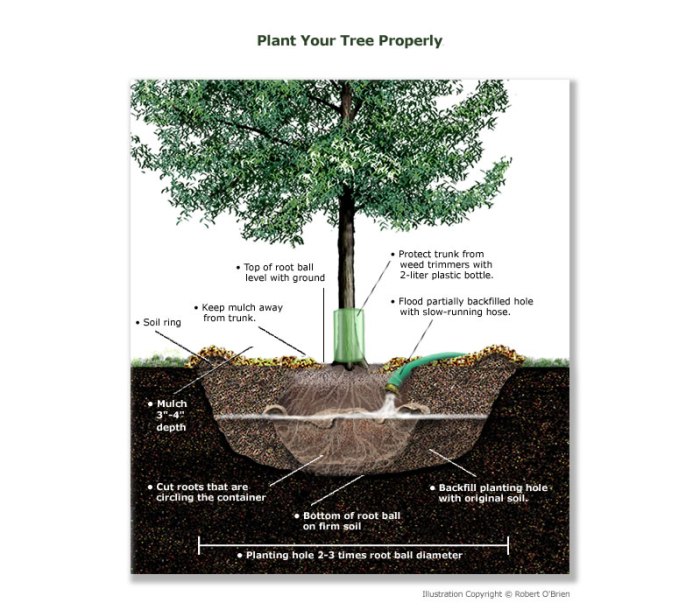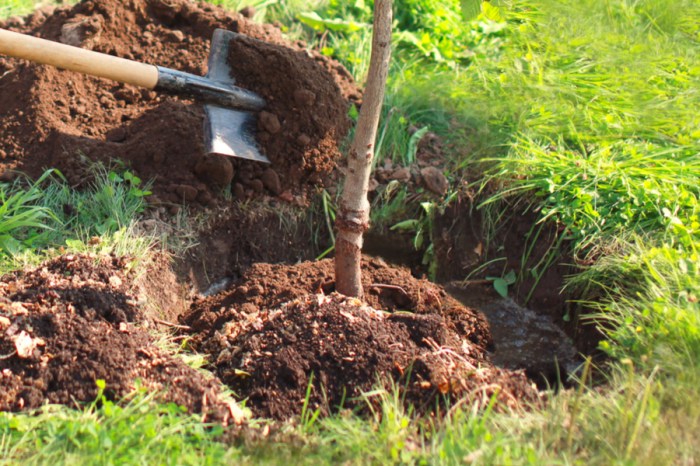Choosing the Right Tree

How to plant a large tree – Selecting the appropriate tree for planting is a crucial step, impacting the tree’s longevity, health, and overall aesthetic contribution to your landscape. Careful consideration of several factors ensures a successful planting and a thriving tree for years to come. Ignoring these factors can lead to a tree that struggles to grow or even dies prematurely.
Successfully planting a large tree requires careful planning and execution. A key consideration is the timing, which depends heavily on the species; for example, understanding when to plant apple trees in Michigan is crucial for their establishment. Proper soil preparation and adequate watering are equally important after planting your large tree to ensure its long-term health and growth.
Factors to Consider When Selecting a Large Tree
The selection of a large tree involves careful consideration of various factors to ensure its suitability for the planting site and its long-term health. These factors should be assessed before making a purchase.
| Mature Size | Growth Rate | Hardiness Zone | Soil Requirements |
|---|---|---|---|
| Consider the ultimate height and spread of the tree at maturity. Ensure there’s sufficient space to accommodate its full size without interfering with structures or other plantings. For example, a mature oak tree might reach 70 feet tall and 50 feet wide, requiring a significant amount of space. | Growth rate varies greatly among tree species. Fast-growing trees can quickly fill a space, but may have shorter lifespans or require more maintenance. Slow-growing trees offer a more gradual development, but may require more patience. For instance, a Leyland Cypress is known for its rapid growth, while a Japanese Maple is considerably slower. | Hardiness zones indicate the range of temperatures a tree can tolerate. Choosing a tree suited to your local hardiness zone is vital for its survival. Consulting a USDA Plant Hardiness Zone map is essential for this determination. | Different trees have varying soil preferences regarding pH, drainage, and fertility. Matching the tree’s needs to your soil conditions is crucial for its health. For example, azaleas thrive in acidic soil, while many conifers prefer well-drained soil. |
Deciduous vs. Evergreen Trees
Deciduous trees lose their leaves annually, offering seasonal color changes and shade in the summer, but no shade or windbreak in the winter. Evergreen trees retain their leaves year-round, providing consistent shade and wind protection, but may require more pruning to maintain their shape. Consider the aesthetic appeal and practical benefits of each type in relation to your needs.
For example, maples are deciduous, while pines are evergreen.
Fast-Growing vs. Slow-Growing Trees
Fast-growing trees quickly establish themselves and provide shade or screening more rapidly. However, they may have shorter lifespans and require more frequent pruning. Slow-growing trees offer a more gradual development and may have longer lifespans, requiring less maintenance in the long run. The choice depends on your priorities and the timeframe you have available. For example, Poplars are known for their rapid growth, while Redwoods are a classic example of slow growth.
Researching Specific Tree Needs
Thorough research into the specific needs of the chosen tree species is paramount. This includes understanding its sunlight requirements, water needs, susceptibility to pests and diseases, and any special cultural practices required for optimal growth. Reliable sources such as university extension services, reputable nurseries, and botanical gardens can provide detailed information. Failing to adequately research a tree species can lead to difficulties in its establishment and ongoing care.
For instance, a specific variety of oak may require specific soil pH levels, while another might tolerate a wider range.
Post-Planting Care: How To Plant A Large Tree
Proper post-planting care is crucial for the survival and healthy growth of a large tree. Neglecting this vital stage can lead to stress, disease, and even the death of the newly planted tree. Consistent attention to watering, mulching, and pest/disease monitoring will significantly improve the chances of successful establishment.
Watering Schedule for the First Year
A newly planted large tree requires consistent watering, especially during its first year. The frequency and amount of water will vary depending on the season, rainfall, soil type, and tree species. However, a general guideline is to provide deep, infrequent watering rather than shallow, frequent watering. This encourages deep root growth. Shallow watering only wets the topsoil, preventing roots from reaching deeper moisture sources.
- Spring (March-May): Water deeply once a week, or more frequently if rainfall is minimal. Aim for a thorough soaking, ensuring the water reaches the root ball and beyond.
- Summer (June-August): Increase watering frequency to two or three times a week, or even daily during prolonged hot and dry periods. Monitor soil moisture closely; the top few inches should be allowed to dry slightly between waterings to avoid root rot. Early morning watering is best to minimize water loss through evaporation.
- Autumn (September-November): Reduce watering frequency to once a week, or less if rainfall is sufficient. The goal is to maintain soil moisture but not encourage new growth before winter.
- Winter (December-February): Water only if the ground is frozen or extremely dry. Deep watering in late autumn before the ground freezes can provide a reservoir of moisture for the tree to draw on during winter.
Mulching Benefits and Methods, How to plant a large tree
Mulching provides numerous benefits for newly planted trees. It helps retain soil moisture, regulate soil temperature, suppress weeds, and improve soil structure over time. Organic mulches, such as wood chips, shredded bark, or compost, are ideal.Applying a 2-4 inch layer of mulch around the base of the tree, keeping it a few inches away from the trunk, is recommended.
Avoid piling mulch directly against the trunk, as this can create a favorable environment for pests and diseases. Reapply mulch as needed to maintain the desired depth throughout the year.
Potential Problems and Preventative Measures
Several problems can affect newly planted large trees. Early detection and preventative measures are key to ensuring the tree’s survival.
- Transplant Shock: This occurs when a tree struggles to adjust to its new environment. Symptoms include wilting, leaf drop, and stunted growth. Careful planting, proper watering, and mulching can help mitigate transplant shock.
- Pest Infestations: Insects and other pests can damage leaves, branches, and even the tree’s roots. Regular inspection for signs of infestation, such as holes in leaves or unusual insect activity, is important. Contact a certified arborist for advice on appropriate pest control measures.
- Diseases: Fungal and bacterial diseases can weaken or kill a tree. Proper watering to avoid root rot, good air circulation around the tree, and maintaining tree health through proper fertilization can help prevent disease. Consulting an arborist is recommended if signs of disease are observed.
Tree Support and Staking

Newly planted large trees are vulnerable to wind damage, especially during their initial establishment phase. Their root systems haven’t yet fully developed to provide adequate anchorage in the ground. Proper staking provides crucial support, allowing the tree to grow strong and straight without being uprooted or severely stressed by strong winds. This support is temporary, however, and the goal is to remove the stakes once the tree is self-supporting.Staking a large tree requires careful consideration to avoid damaging the trunk or restricting root growth.
Incorrect staking can lead to girdling, where the stake rubs against the bark, restricting the flow of nutrients and potentially killing the tree. Therefore, understanding the proper techniques is vital for the tree’s long-term health and survival.
Staking Methods
Choosing the appropriate staking method depends on the size of the tree and the environmental conditions. The following table compares three common methods:
| Staking Method | Description | Advantages | Disadvantages |
|---|---|---|---|
| Three-Stake Method | Three stakes are placed around the tree, forming a triangle. Strong, flexible ties are used to secure the tree to the stakes, ensuring the tree remains centered and upright. The ties should be loose enough to allow for some tree movement. | Provides good stability and distributes stress evenly. Relatively easy to install. | Can still cause damage if not installed correctly. Requires careful monitoring and adjustment as the tree grows. |
| Single-Stake Method | A single stake is placed on the side most exposed to prevailing winds. A flexible tie is used to secure the tree, allowing for some movement. | Simple and inexpensive. | Provides less support than the three-stake method and can cause the tree to lean. Increased risk of damage to the trunk. |
| Guy Wire Method | Strong wires are attached to the tree and anchored to heavy stakes driven into the ground several feet from the tree. This method offers strong support, particularly in windy areas. | Provides excellent stability, especially for large trees in exposed locations. | More complex to install than other methods. Requires more materials and potentially professional installation. Can cause damage if installed improperly. |
Stake Removal
Once the tree has developed a strong root system and is able to withstand wind forces on its own, the stakes should be removed to prevent girdling. This usually occurs after a few years, depending on the tree species and growth rate. Visual indicators of readiness include the tree’s ability to sway slightly in the wind without leaning excessively, and the trunk showing no signs of damage from the stakes or ties.To remove the stakes, carefully loosen the ties and remove them completely.
Then, gently pull the stakes out of the ground, taking care not to disturb the tree’s root system. Any remaining holes should be filled with soil. The removal process should be gradual, potentially over several weeks to minimize stress on the tree. Observe the tree for several weeks after stake removal to ensure it remains stable.
Top FAQs
What type of tree is best for my climate?
Consult your local agricultural extension office or nursery for recommendations based on your specific hardiness zone and soil conditions.
How often should I water a newly planted large tree?
Water deeply and regularly, especially during dry periods, aiming for consistently moist soil but avoiding waterlogging. Frequency will depend on weather conditions and soil type.
When should I remove the tree stakes?
Remove stakes once the tree is firmly established and no longer swaying in the wind, typically after one to two years.
What is the best time of year to plant a large tree?
The best time is generally during the dormant season (fall or early spring) to minimize stress on the tree.
